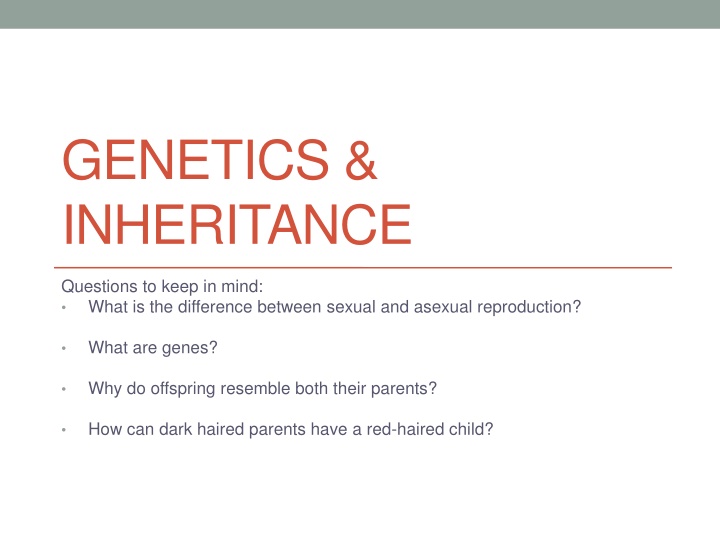
Genetics and Inheritance: Key Concepts Explained
Explore the differences between sexual and asexual reproduction, the role of genes, and how traits are inherited from parents. Discover why offspring resemble both parents and learn how genes determine physical characteristics. Unravel the mystery of how dark-haired parents can have a red-haired child through a clear and concise explanation.
Download Presentation

Please find below an Image/Link to download the presentation.
The content on the website is provided AS IS for your information and personal use only. It may not be sold, licensed, or shared on other websites without obtaining consent from the author. If you encounter any issues during the download, it is possible that the publisher has removed the file from their server.
You are allowed to download the files provided on this website for personal or commercial use, subject to the condition that they are used lawfully. All files are the property of their respective owners.
The content on the website is provided AS IS for your information and personal use only. It may not be sold, licensed, or shared on other websites without obtaining consent from the author.
E N D
Presentation Transcript
GENETICS & INHERITANCE Questions to keep in mind: What is the difference between sexual and asexual reproduction? What are genes? Why do offspring resemble both their parents? How can dark haired parents have a red-haired child?
What is reproduction? Reproduction is a biological process used by organisms to create new individuals so the species can continue. Asexual reproduction occurs when one parent cell divides into two cells to create a new organism. (bacteria and some plants) Sexual reproduction occurs when two different parent cells come together to form a new individual. (animals and flowering plants) The cells that join together in sexual reproduction are called gametes, also known as sex cells. The human gametes are the sperm and the egg. They each carry half the genetic code of the parent.
What is genetic material? DNA is the name given to the structure, made of sugars and proteins, that controls the functions of a cell. A gene is a section of DNA that performs a task. Genes also work together to control characteristics about an organism, e.g. hair/fur/eye/bark/flower colour, leaf shape, number of legs . . . DNA folds itself into different shapes called chromosomes that are located in the nucleus of each cell
Passing on genes During sexual reproduction the DNA from both parents mixes together to form the DNA of the new organism
Which to gene choose? When the DNA mixes, there will be two of each gene, one from each parent. Depending on the gene, sometimes both can work together or sometimes one gene will control everything itself. We call genes that win out over other genes dominant genes. Genes that lose out to dominant genes are called recessive genes.
Which to gene choose? In genetics, dominant genes are given a capital letter and recessive genes are given the same letter but in lower case letter. For example, dark hair is dominant over red hair. In this case we will call dark hair D and red hair d. Each parent will itself have inherited two copies of each gene from its parents. As a result a when a sperm/egg is made it will have either one gene or the other. Remember sex cells only carry half of the genetic code of the parent.
Which to gene choose? Imagine a scenario where a man has the genes for both dark hair (D) and red hair (d). Because dark hair is dominant he will have dark hair. When the man makes sperm each sperm will either be carrying the gene for dark hair (D) or red hair (d). A woman with red hair must have two copies of the red hair gene (d) as this is the only way to have a recessive gene characteristic. The woman s eggs will always have the red hair gene (d) as that is the only one she has. If the man and the woman conceive a baby there are four possibilities for the mixing of the sperm and egg. If the D carry sperm fertilises the egg, the baby will have dark hair as the D gene is dominant If the d carrying sperm fertilises the egg, the baby will have red hair as that will be the only gene present.
Inheritance The way genes get passed onto offspring explains why offspring usually have characteristics of both parents. It depends on which genes are dominant/recessive. It also explains how characteristics, such as red hair, can skip a generation. It is possible, and very common, to carry recessive genes that then get passed onto offspring. Get Thinking How does this process of passing on genes lead to natural selection and evolution?
